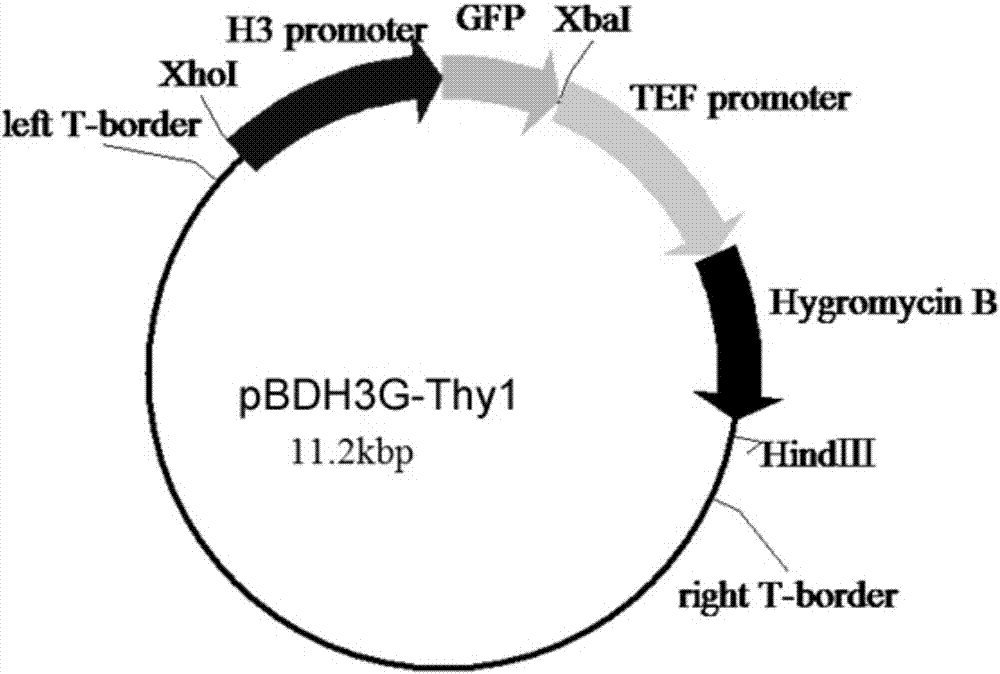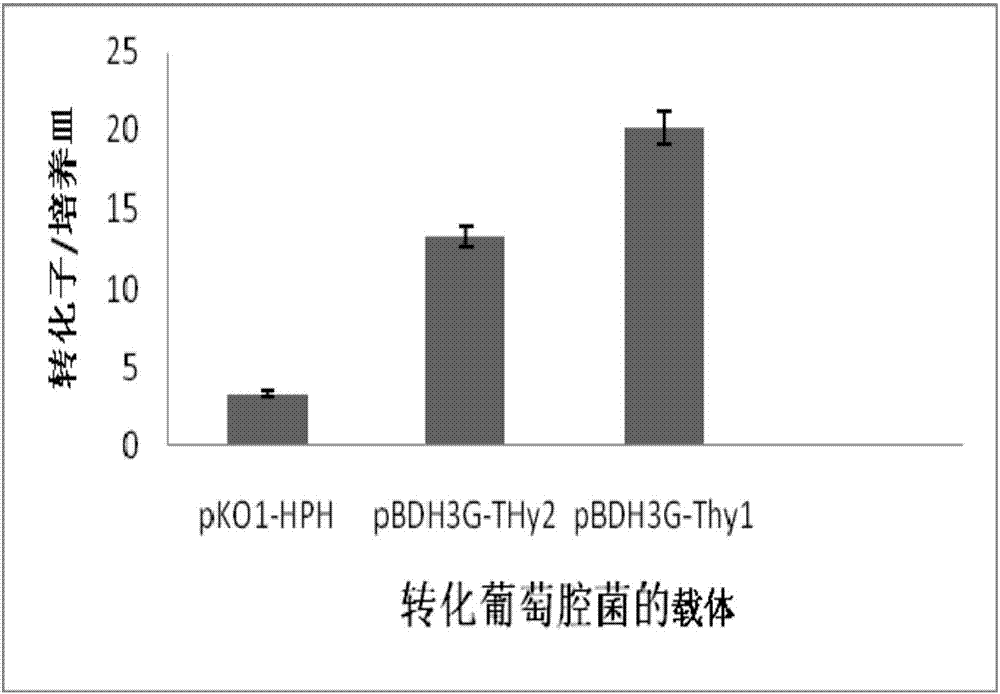Plasmid vector, building method thereof and application
A technology of plasmid vector and botrytis, which is applied in the field of microorganisms, can solve the problems of low transformation efficiency and achieve the effect of improving transformation efficiency
- Summary
- Abstract
- Description
- Claims
- Application Information
AI Technical Summary
Problems solved by technology
Method used
Image
Examples
Embodiment 1
[0054] Example 1 Construction of the plasmid vector pBDH3G-Thy for efficient transformation of Botrytis
[0055] Plasmid pEGFP of the present invention was purchased from CLONTECH Company; information on plasmid pCAMBIA1300: Hajdukiewicz P, Svab Z, Maliga P (1994) The small, versatile pPZP family of Agrobacterium binary vectors for plant transformation.Plant Mol Biol 25:989-994.; Information on plasmid pCB1003 : Carroll AM, Sweigard JA, Barbara VC (1994) Improved vectors for selecting resistance to hygromycin. Fungal Genetic News, 41:22. The above three plasmids are all kept in the Fungal Biology Laboratory of Agricultural College of Zhejiang University.
[0056] In the Botrytis genome database ( http: / / genome.jgi.doe.gov / Botdo1 / Botdo1.home.html ) to find the histone H3 gene and the transcription elongation factor α (TEF) gene of Botrytis aureus, respectively download about 1500 bp upstream (containing the promoters of the respective genes), and then design primers. Then use...
Embodiment 2
[0077] Example 2 Preparation of Botrytis botrytis protoplasts
[0078] 1. Preparation of reagents and medium
[0079] (1) 0.7M sodium chloride solution: 40.95g of sodium chloride (NaCl) was dissolved in 1000mL of water, and then subjected to conventional high-temperature sterilization (1.1 atmospheres, 121°C for 20 minutes).
[0080] (2) 1M Tris-Cl, pH=7.5: Tris(hydroxymethyl)aminomethane (Tris(hydroxymethyl)aminomethane, generally abbreviated as Tris) 121.14 was dissolved in 600mL redistilled water, adjusted to pH=7.5 with concentrated hydrochloric acid, and then redistilled Dilute the water to 1 L, perform conventional high-temperature sterilization (1.1 atmospheres, sterilize at 121°C for 20 minutes), and set aside.
[0081] (3) Cell wall degrading enzyme solution: Weigh 100 mg of Driselase and 100 mg of Lysing Enzyme on a balance, dissolve them in 10 mL of 0.7M sodium chloride solution, and filter them with a diameter of 0.22 μm Sterilized by membrane filtration, ready to ...
Embodiment 3
[0094] Example 3 Agrobacterium-mediated botrytis DNA transformation
[0095] 1. Preparation of Botrytis strain FY-31:
[0096] Inoculate the PDA plate with the Botrytis strain FY-31 preserved in our laboratory, culture it at 25°C for 5 days, and set it aside.
[0097] 2. Plasmid preparation
[0098] The pBDH3G-Thy1 and pBDH3G-Thy2 in Example 1, and the PKO1-HPH plasmid used for the control were extracted, and the concentration of the plasmid was adjusted to 0.25 μg / μL.
[0099] 3. Transform the plasmid vector into Agrobacterium by freeze-thaw method
[0100] (1) The formula of LB solid medium is as follows: tryptone (Trypone) 10g, yeast extract (Yeast extract) 5g, sodium chloride (NaCl) 10g, agar 15g, water 1000mL, pH=7.0. Routine high-temperature sterilization (1.1 atmospheres, 121°C for 20 minutes).
[0101] LB liquid medium: Agar is not added to LB solid medium, and the others are the same.
[0102] (2) Agrobacterium strain AGL1 was streaked and activated on LB plates,...
PUM
| Property | Measurement | Unit |
|---|---|---|
| diameter | aaaaa | aaaaa |
Abstract
Description
Claims
Application Information
 Login to View More
Login to View More - R&D
- Intellectual Property
- Life Sciences
- Materials
- Tech Scout
- Unparalleled Data Quality
- Higher Quality Content
- 60% Fewer Hallucinations
Browse by: Latest US Patents, China's latest patents, Technical Efficacy Thesaurus, Application Domain, Technology Topic, Popular Technical Reports.
© 2025 PatSnap. All rights reserved.Legal|Privacy policy|Modern Slavery Act Transparency Statement|Sitemap|About US| Contact US: help@patsnap.com



